Kassalong reserve forest
Contributors to Wikimedia projects
Kassalang reserve forest (Bengali:কাসালাং সংরক্ষিত বন) is an evergreen mountainous forest in Bangladesh. It covers an area of 1485 square kilometer (1,48500 hactare / 3,66,952 acres). It is a protected area in Bangladesh. Kassalang reserve forest is one of the largest and dense forest in Bangladesh. The area of Kassalang is far away from human residence that make it special for nature lovers. It houses Bangladesh's richest wildlife resource after Sundarbans and Sangu Matamuhari. It is under the Baghaichari. Forest Division of the Forest Department (Bangladesh). It is a 9a bio-ecological zone in Chittagong Hill Tracts. [1]
| Kassalong reserve forest | |
|---|---|
| File:KR Forest.png kassalong forest landscape | |
| Location | Rangamati District, Chittagong Division, Bangladesh |
| Nearest city | Rangamati |
| Coordinates | 23°10′22″N 92°10′01″E / 23.17278°N 92.16694°E |
| Area | 1,48,500 hactare |
| Elevation | 170 meter |
| Established | 1881 |
| Governing body | Bangladesh Forest Department |
Location
Kassalang reserve forest is located 11 km (6.83 mi) north-east of Baghaichari Upazila,Rangamati. It is situated between Latitude of 23°8'43.8" to Longitude of 92°18'1.52" Kassalang share it’s border with Sajek Valley and Dighinala at south, Panchhari at west, Indian state of Tripura at north and Mizoram at east. It covers the northern part ofChittagong Hill Tracts. Lungsir Tlang Mountain range passes through Kassalang reserve forest. Kassalang river has crossed across the forest. The prime water streams of the forest are Tangama chara and Goba chari.[2]
Climate
The Climate is generally humid and warm. Average humidity is 78.02%. The temperature rises up to 37 °C in May and drops down to minimum 8 °C in January. This dense forest enjoys tropical Monsoon from June to September every year.
The warmest month is May (32.72ºC / 90.9ºF), coldest month is January (16.22ºC / 61.2ºF), wettest month is July (453.28mm / 17.85in) and driest month is December (2.04mm / 0.08in).There is 205 days with no rain (56%).
The yearly temperature is 27.17ºC (80.91ºF) and it is -0.57% lower than Bangladesh's averages. Kassalang typically receives about 141.7 millimeters (5.58 inches) of precipitation and has 159.23 rainy days (43.62% of the time) annually. [3]
Geography
Kassalang reserve forest is in a hilly area of eastern highlands. The estimate terrain elevation above seal level is 170 meter. Tertiary sediment had formed this forest’s landscape which contains a decent amount of Iron, which is usually found as Iron oxide. This element makes the soil yellowish. The soil PH is mostly between 5.1 to 5.7 and the valley site soil is much Fertile. [4]
Kassalong River is the main tributary of the Karnafuly river at the northeast of Kassalang reserve forest. The river receives the water of four hilly rivulets that flow north to south. The Kassalong meets with the Karnafuli 20 km north of Rangamati district. The river along with some stream and canal supply Fresh water to the reserve.[5]
Biodiversity
Flora
The general walk in the forest is not easy due to the hilly terrain. Kassalong is also one of the contry's most dense forest decorated with a large diverse floral system. The most important commercial timber species of the Kassalang reserve forest is Pitraj, Civit, Jarul, Gamar, Koroi, Garjan, Chapalish, Toon, Champa, Batna, Udal, Simul, Chandul, etc. There is a large area of Bamboo jungle mostly of Melocanna baccifera. Most of the trees are of the Evergreen type and some are Semi-evergreen type specially the tallest trees. There are some Deciduous and Semi-deciduous trees, so the forest never loses its semi-evergreen look and remain green all year round. 467 plant species were identified, which include 144 tree species, 98 shrub species, 63 climbers, 144 herbs, 11 epiphytes and 7 ferns. [6]
Fauna
Kassalang reserve forest is rich in wildlife resources. There is a decent amount of wild species in this forest. 7 new Mammals, 5 Reptiles and 4 Amphibious species have found in a recent serve. There are 123 species of bird in the forest including Golden-crested myna,one of the most rare Bird species of South Asia. The forest is also the residence of endangered species Great hornbill. Asian elephant, Western hoolock gibbon, Dhole, Wild boar, Rhesus macaque, Capped langur, Southern red muntjac, Sambar deer, Hog deer, Gaur, Asian black bear, Indian leopard, Himalayan serow,Clouded leopard, Asian golden cat, Marbled cat, Burmese python, Arakan forest turtle are the supreme wild species.[7]
Kassalong reserve forest has the highest density ofClouded leopard in the country. The most rare species; Gaurand Himalayan red serow also had discovered in some Camera trap image. There are also some report of Tigersin that area, near kassalang river. Scientists said that there may have a little Tiger population in the forest. Creative Conservation Alliance has found Tiger Pugmarki n the forest. Forest Department (Bangladesh) believe that there is a population of 15-20 Tiger in that forest. [8]
See also
References
- ^ "Kassalong Reserve Forest". The Business Standard. Retrieved 2024-03-11.
- ^ "Kāsālang Reserved Forest forest reserve, Chittagong, Bangladesh". bd.geoview.info. Retrieved 2024-03-11.
- ^ "Rangamati, Chittagong, BD Climate Zone, Monthly Averages, Historical Weather Data". weatherandclimate.com. Retrieved 2024-03-11.
- ^ "Forest and Forestry - Banglapedia". en.banglapedia.org. Retrieved 2024-03-11.
- ^ "Kasalong River - Banglapedia". en.banglapedia.org. Retrieved 2024-03-11.
- ^ Ahmed, Inam (2011-11-18). "Green desert in the hills". The Daily Star. Retrieved 2024-03-11.
- ^ "Kassalong: High time to save the dwindling forest". The Business Standard. 2020-03-21. Retrieved 2024-03-11.
- ^ মাহমুদ, ইফতেখার (2021-08-01). "কাসালং বনে বাঘের অস্তিত্ব". Prothomalo (in Bengali). Retrieved 2024-03-11.
